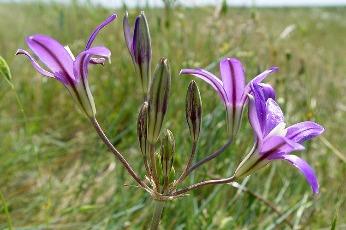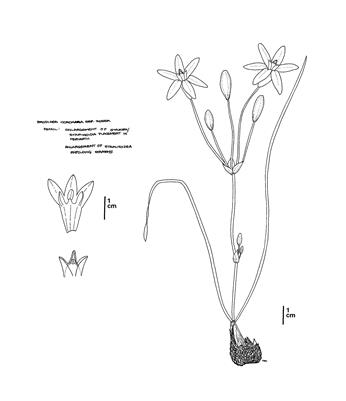(Brodiaea rosea)
 Brodiaea rosea. Photo © Carol Witham.
Brodiaea rosea. Photo © Carol Witham.
 Brodiaea rosea. CDFW illustration by Mary Ann Showers. (Click to enlarge)
Brodiaea rosea. CDFW illustration by Mary Ann Showers. (Click to enlarge)
Indian Valley brodiaea is a California endangered plant species, which means that killing or possessing this plant is prohibited by the California Endangered Species Act (CESA). This species is a perennial bulbiferous herb of the brodiaea family (Themidaceae), that produces long narrow leaves from an underground corm and bears rosy pink or violet flowers on leafless flowering stems. This plant typically blooms from May to June and appears to be restricted to serpentine clay and gravel in open areas along drainages in chaparral and closed-cone conifer forests. The range of this species extends through parts of Colusa, Glenn, Lake, Shasta, Tehama, and Trinity Counties. At the time of this webpage posting, the California Natural Diversity Database reports 20 natural occurrences of this species that are presumed to still exist and one occurrence that has possibly been extirpated.
The filling of Indian Valley Reservoir in 1975 destroyed most of Indian Valley brodiaea's historic range. Part of the plant's habitat in Glenn County is used as a local dump. At the time of State listing in 1979 the most significant threat to the species was habitat destruction and water levels at the Indian Valley Reservoir. The Bureau of Land Management has protected 40 acres of Indian Valley brodiaea habitat in the Indian Valley Area of Critical Environmental Concern. This plant’s most significant threats today are trampling, vehicles, dumping, and horticultural collection as well as the threat of climate change.
A study published in Systematic Botany in 2013 suggests that Brodiaea rosea has many non-serpentine populations and proposes that this species should be split into two subspecies, B. rosea subsp. rosea and B. rosea subsp. vallicola.
Long term conservation of Indian Valley brodiaea is dependent on continued protection, genetic study and establishment of a taxonomic framework that can resolve the poorly understood relationships within the brodiaea family. Genetic and molecular data will be needed to identify whether there are co-occurring subspecies and tell us whether there is a difference between serpentine and non-serpentine endemic populations.
CDFW may issue permits for Indian Valley brodiaea pursuant to CESA, and you can learn more about the California laws protecting Indian Valley brodiaea and other California native plants. Populations of Indian Valley brodiaea occur in CDFW’s Northern Region and North Central Region.